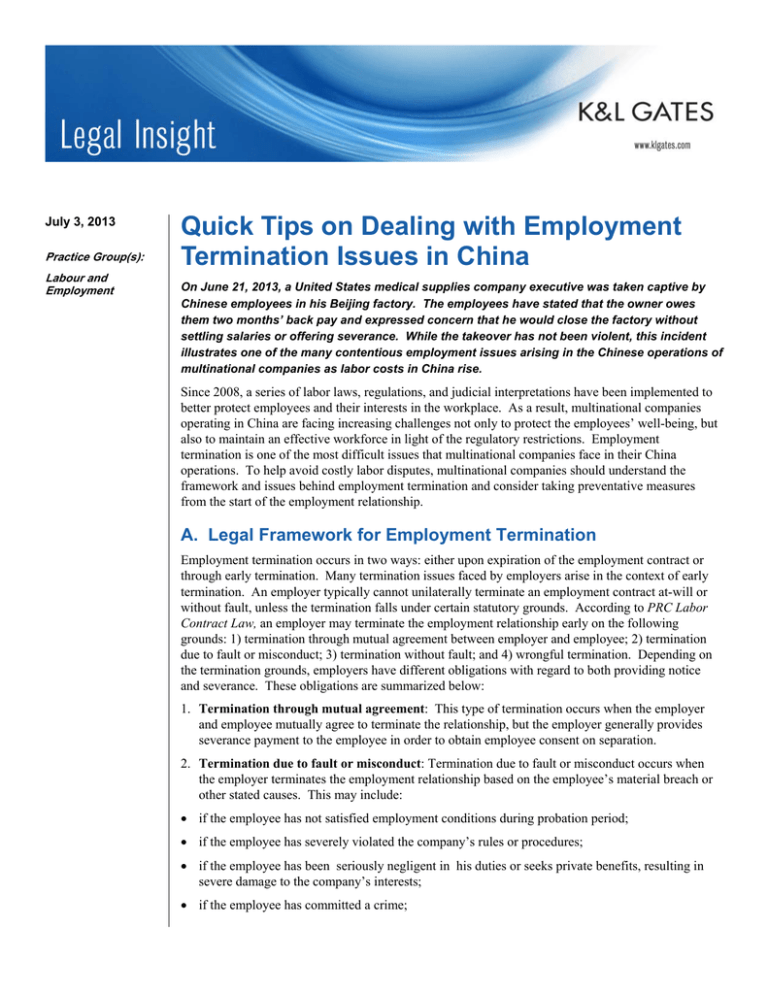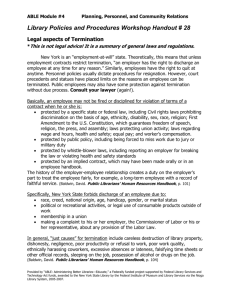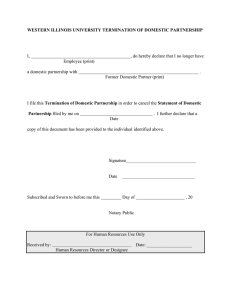
July 3, 2013
Practice Group(s):
Labour and
Employment
Quick Tips on Dealing with Employment
Termination Issues in China
On June 21, 2013, a United States medical supplies company executive was taken captive by
Chinese employees in his Beijing factory. The employees have stated that the owner owes
them two months’ back pay and expressed concern that he would close the factory without
settling salaries or offering severance. While the takeover has not been violent, this incident
illustrates one of the many contentious employment issues arising in the Chinese operations of
multinational companies as labor costs in China rise.
Since 2008, a series of labor laws, regulations, and judicial interpretations have been implemented to
better protect employees and their interests in the workplace. As a result, multinational companies
operating in China are facing increasing challenges not only to protect the employees’ well-being, but
also to maintain an effective workforce in light of the regulatory restrictions. Employment
termination is one of the most difficult issues that multinational companies face in their China
operations. To help avoid costly labor disputes, multinational companies should understand the
framework and issues behind employment termination and consider taking preventative measures
from the start of the employment relationship.
A. Legal Framework for Employment Termination
Employment termination occurs in two ways: either upon expiration of the employment contract or
through early termination. Many termination issues faced by employers arise in the context of early
termination. An employer typically cannot unilaterally terminate an employment contract at-will or
without fault, unless the termination falls under certain statutory grounds. According to PRC Labor
Contract Law, an employer may terminate the employment relationship early on the following
grounds: 1) termination through mutual agreement between employer and employee; 2) termination
due to fault or misconduct; 3) termination without fault; and 4) wrongful termination. Depending on
the termination grounds, employers have different obligations with regard to both providing notice
and severance. These obligations are summarized below:
1. Termination through mutual agreement: This type of termination occurs when the employer
and employee mutually agree to terminate the relationship, but the employer generally provides
severance payment to the employee in order to obtain employee consent on separation.
2. Termination due to fault or misconduct: Termination due to fault or misconduct occurs when
the employer terminates the employment relationship based on the employee’s material breach or
other stated causes. This may include:
if the employee has not satisfied employment conditions during probation period;
if the employee has severely violated the company’s rules or procedures;
if the employee has been seriously negligent in his duties or seeks private benefits, resulting in
severe damage to the company’s interests;
if the employee has committed a crime;
Quick Tips on Dealing with Employment Termination
Issues in China
if the employee has additionally established an employment relationship with another employer
which materially affects completion of his tasks with the first employer, or refuses to rectify the
matter after the employer points out the problem; or
if the employee has deceived, coerced, or taken advantage of the employer’s difficulties, to cause
the employer to conclude an employment contract, or to make an amendment, contrary to the
employer’s true intent.
When an employer terminates an employee for fault or misconduct, notice and severance are not
required.
3. Termination without fault: Termination without fault occurs when the employer terminates the
employment relationship for reasons not related to misconduct or for other stated causes. This
includes:
if the employee is sick or has sustained a non-work related injury and, after conclusion of the
statutory medical treatment period, cannot engage in the original work or in other arranged work;
if the employee is incompetent and remains incompetent after training or assignment to another
post; or
if performance of the original employment contract becomes impossible due to a material change
in the objective circumstances upon which the employment contract was based at the time it was
entered, and consultations between the parties fail to produce agreement on amendment of the
contract.
When termination is without fault, the employer must provide 30 days’ advance written notice or pay
one month salary in lieu of the notice, in addition to the severance payment. The employer must also
provide notice to the labor union before any unilateral termination. Certain groups of employees may
not be terminated without fault, such as employees who are pregnant, and employees who have lost or
partially lost the capacity to work due to occupational disease contracted during the employment
period.
Where a material change in circumstances causes the economic layoff of either 20 or more
employees, or 10% of the workforce , the employer must provide 30 days’ notice of the reduction plan
to a labor union and to all employees and then submit the plan to the local labor bureau. Employees
with long fixed-term contracts, open-term contracts, or who are the only breadwinners in the family
should receive priority with regard to retention. As previously mentioned, certain groups, such as
pregnant employees may not be terminated. Upon submitting the plan to the local bureau, the
employer may terminate the employment relationship under the following circumstances:
where employer has severe difficulties in its production or operations;
where employer is restructuring according to Enterprise Bankruptcy Law;
if the employer changes products, introduces a major technological innovation, or adjusts its
business operation methods, and after amendment of employment contracts, still needs to reduce
employees;
where the objective economic situation upon which the labor contract is based has considerably
changed, and the employer is unable to perform the labor contract.
2
Quick Tips on Dealing with Employment Termination
Issues in China
4. Wrongful termination: Beside the above statutory grounds, any other types of unilateral
termination would be considered wrongful. In the event of a wrongful termination, the employer
may resolve the matter through arbitration / litigation, or through settlement, both of which may
involve high legal costs and settlement fees. Employers should note that in the case of a wrongful
termination, an employee can ask for reinstatement. If an employee does not wish to continue
working for the employer or if reinstatement is not possible, then the employer must pay the
employee double the amount of severance that would need to be paid if the employee had been
lawfully terminated. Furthermore, the employer may be liable for salary payments during the
period in which the terminated employee cannot work, which may result in higher settlement costs
for the employer.
B. Practical Measures for Dealing with Employment Termination
Given the above framework, employers may take a number of practical and preventative measures to
avoid costly labor disputes. Employers should be mindful of which types of termination situations
where notice or severance payments are necessary. Employers should also note the statutory required
amount for severance payments, such as providing a statutory severance payment of one month’s
wage for each full year of service (except for termination during probation or for cause), one month’s
wages for less than a full year but greater than six months of service, and half month’s wage for less
than six months of service. When dealing with the employment termination process, employers
should ask themselves the following questions:
During hiring and employment period:
Has our company created a detailed employee handbook for employees to sign and acknowledge?
Has our company properly defined standards of “materiality” and seriousness” in our disciplinary
policy and handbook, as well as objective appraisal benchmarks for evaluating competency?
Has our company maintained detailed records of the employees’ performance?
Has our company provided proper alternatives, such as additional training or alternative positions,
to employees prior to termination?
Has our company established proper employee consultation and dispute resolution procedures?
During termination and post-termination period:
Has our company drafted proper full releases for employees to sign in the event of a termination?
Has our company paid any unpaid wages and settled for the proper amount to prevent future
disputes?
Has our company implemented proper post-termination procedures, such as providing written
statements explaining termination and relaying important information regarding what to expect
post-termination?
K&L Gates lawyers can assist companies in dealing with labor and employment law matters. If you
have any questions regarding this alert, please contact the K&L Gates Beijing office.
3
Quick Tips on Dealing with Employment Termination
Issues in China
Authors:
Yujing Shu
yujing.shu@klgates.com
+86.10.5817.6100
Hai-Ching Yang
hai-ching.yang@klgates.com
+86.10.5817.6102
Anchorage Austin Beijing Berlin Boston Brisbane Brussels Charleston Charlotte Chicago Dallas Doha Dubai Fort Worth Frankfurt
Harrisburg Hong Kong Houston London Los Angeles Melbourne Miami Milan Moscow Newark New York Orange County Palo Alto Paris
Perth Pittsburgh Portland Raleigh Research Triangle Park San Diego San Francisco São Paulo Seattle Seoul Shanghai Singapore Spokane
Sydney Taipei Tokyo Warsaw Washington, D.C. Wilmington
K&L Gates practices out of 48 fully integrated offices located in the United States, Asia, Australia, Europe, the
Middle East and South America and represents leading global corporations, growth and middle-market companies,
capital markets participants and entrepreneurs in every major industry group as well as public sector entities,
educational institutions, philanthropic organizations and individuals. For more information about K&L Gates or its
locations, practices and registrations, visit www.klgates.com.
This publication is for informational purposes and does not contain or convey legal advice. The information herein should not be used or relied upon in
regard to any particular facts or circumstances without first consulting a lawyer.
©2013 K&L Gates LLP. All Rights Reserved.
4



